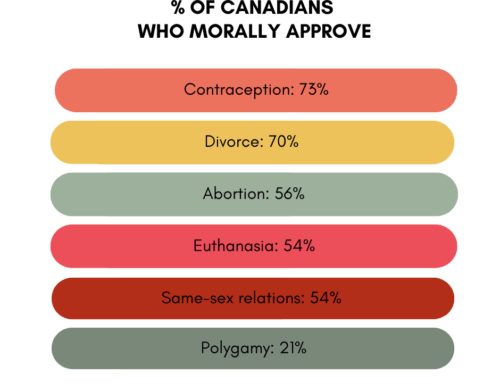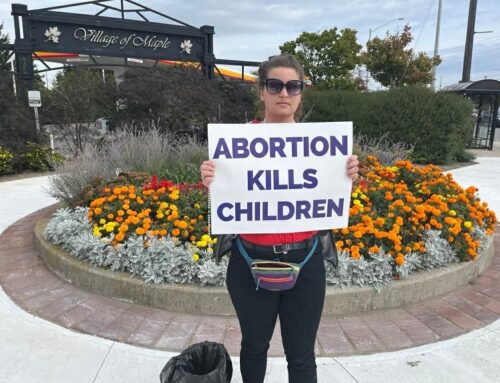From the editor’s desk
Paul Tuns:

From the editor’s desk
Kevin Yuill writes about the eugenic roots of the euthanasia movement in Spiked:
“This campaign of involuntary euthanasia, known as Aktion T4, cost tens of thousands of lives. According to the Nazis’ own record, at least 70,000 disabled people were put to death, although some sources suggest that the figure could be as high as 200,000.
“It is tempting to believe that the eugenic ethos that informed this methodical, murderous campaign died with the defeat of the Nazis. But that is wishful thinking. The eugenicist approach, which measures the worth of all according to whether or not they are a net ‘benefit’ or ‘burden’ to society – indeed, whether they add to or subtract from the nation / community / race – has proven stubbornly persistent. And it is now enjoying a resurgence with the worldwide push for assisted-dying laws …
“Indeed, it is no coincidence that the idea of euthanasia emerged at the same time as eugenics. The two were always conceptually and politically entwined. From the start, the implications of euthanasia were always eugenic. Samuel D Williams, a member of the Birmingham Speculative Club, first raised the prospect of euthanasia in an 1870 pamphlet of the same name. Williams made the case for taking a life away ‘that has ceased to be useful to others, and has become an unbearable infliction to its possessor’. In her 1885 book, My Path to Atheism, socialist and euthanasia advocate Annie Besant argued for ‘relieving (society) from a useless burden.’
“Today, the callous justification for voluntary euthanasia, assisted suicide or assisted dying tends to be hidden behind appeals to compassion. Euthanasia is presented as a way to end the unbearable suffering of desperate individuals. But prior to the 1930s, few hid the true intentions of euthanasia – to improve society by ridding it of burdensome lives.”
The advocates of euthanasia, like those who promote abortion, claim that the eugenic roots of their lethal causes are remnants of a distant past and have nothing to do with their supposedly compassionate and caring motivations today. Yet the Canadian experience, in which disabled veterans and patients with chronic illness who want to live are aggressively steered toward Medical Assistance in Dying, suggests that the ugly eugenic underbelly of this movement is never far from its practice.
**
In the May edition of Commentary, Hannah E. Meyers, director of policy and public policy at the Manhattan Institute, writes of a number of disturbing recent crimes committed by individuals who identify as non-binary or transgender, including the school massacre at the Covenant School in Tennessee last year. Meyers asks: “Do transgender Americans commit crime at higher rates or of different types than ‘cis-gender’ Americans?” (Cis-gender is the (usually) derogatory term used against people whose gender identity matches their biological sex.) Meyers says “we have no idea” how to answer those questions – and I would add that Officialdom, including the usual collector of such statistics, must certainly have no interest in finding the answer to Meyer’s question. Meyers reports that “we are not systemically collecting or analyzing stats for trans offenders” because “it’s too politically uncomfortable to call attention to transgender people as anything but victims.” She writes that any attempt to delve into the criminological and sociological literature on transgenderism and crime finds that it “focuses exclusively on trans victimization.” This is not merely an academic matter. In 2019, New York city council required the Board of Corrections to establish the Transgender, Gender Non-Conforming, and Non-Binary (TGNCNBI) Task Force to, in the words of the bill’s sponsor, make the city “a leader when it comes to upholding the dignity of TGNCNBI incarcerated people.” As Meyers observes, “the mandate, in other words, sets up transgender inmates as victims.” The sponsor, Helen Rosenthal claims “TGNCNBI people have been overpoliced and over-incarcerated.” The problem is, neither Rosenthal, nor anyone else, knows if that is true because there is a dearth of studies about transgender criminal offenders in the United States (and, I would add, Canada).
There is a small number of studies outside the U.S. that examine trans crime. A 2011 Swedish study found that transgender individuals who have had sex re-assignment surgery commit crime, violence, and sexual violence at much higher rates than the general public. Furthermore, men who believe they become female retain “a male pattern regarding criminality.” That fact raises an interesting question about the essential nature of maleness and femaleness, and to what extent re-assignment can change that nature. A British study found that 59 per cent of “transwomen” – men who “become” or otherwise identify as women – prisoners were sex offenders, compared to three per cent of biological women and 17 per cent of biological men. A Finnish study “found that trans adolescents were more likely to be bullies than the victims of bullying.” (That’s a curious fact that should challenge certain narratives dictating school policies.)
The lack of statistics regarding trans crime patterns undermines public safety. As Meyers argues, “if we don’t study and understand crime patterns, we can’t protect people from those crimes.” Disappointingly, but hardly surprisingly, the experts desire to put identity-group interests ahead of sound public policy. Meyers says this is all part of a long-term problem in criminology in which actual crime is downplayed.
**
Hannah Meyers makes note of a horrible murder, that of Sam Nordquist, a man who identified as a woman, earlier this year in New York City. Audacia Ray, interim executive director of the New York City Anti-Violence Project, said the attack was made possible by growing anti-trans sentiment in the United States and the “cultural indifference to the humanity of the LGBTQ people.” Meyers reports that the police are not treating the case as a hate crime, certainly because two of Nordquist’s killers themselves identify as transgender.
**
Two cheers for sensible policy coming out of … Quebec. Public Security Minister Francois Bonnardel announced June 18 that “transgender inmates” will be incarcerated according to their anatomical sex, not their gender identity, although he left the door open to some exceptional accommodations. Going back to Meyers’ Commentary article, there is a “special danger to female inmates posed by a roommate who has the physical strength, higher propensity to violence, and penis of a man.” As Meyers insists, “of course, genitalia matters.”
**
Over the span of four days in June, the Daily Telegraph had a pair of reports on trans madness related to pregnancy. One story was about the Queer Birth Club providing breastfeeding workshops to train midwives with the National Health Service (NHS). The promotional poster claimed, “Birthing people ain’t all women.” One member of the NHS staff complained, saying “The content of these sessions undermines established clinical standards and introduces extreme ideological beliefs that have no place in healthcare settings.” Of course, she is facing disciplinary action. The Queer Birth Club has a label for those who deny that men can breastfeed or that milk produced by “trans women” is inferior: “transmisogyny.” Men who identify as women are sometimes given Domperidone to stimulate lactation, but Janssen, the drug’s manufacturer, recommends against it because of possible side-effects to newborn babies. The Queer Birth Club is pretty mainstream in pregnancy circles in the UK, having presented to the Royal College of Midwives, Make Birth Better, the Positive Birth Company, and university medical and social work programs. AJ Silver, the non-binary founder of the Queer Birth Club claims to have trained more than 600 birth professionals.
Meanwhile, a report by the Department for Transportation labeled mothers-to-be “pregnant participants,” which the Telegraph called an “example of (the) public sector attempting to erase women’s rights.” The report was written by Clare Mutzenich of Lacuna Agency, a consultancy, and it examined how various types of passengers would theoretically react to emergencies in a self-driving taxi. One group examined was pregnant women – although the report studiously eschewed that phrase. It did, however, use the term “pregnant participants” nine times. Other phrases included in the report were “pregnant passengers”, “pregnant users” and “pregnant individuals.” Neither the word “mother” nor the phrase “pregnant woman” appeared in the report at all, while the word transgender was used 14 times. Of the two times that the word “woman” appeared, once was in the context of “transgender woman” – that is, a biological man pretending to be a woman. Helen Joyce, the director of Sex Matters, described the study’s avoidance of the phrase “pregnant women” as forming “part of a broader erasure of women’s needs.” She said, “It’s very telling that the DfT refers to ‘pregnant passengers’ rather than pregnant ‘women’ in a study looking at how people with different protected characteristics may respond in an emergency situation,” adding, “Only women can have the protected characteristic of ‘pregnancy and maternity’, and this study both obscures that fact and fails to consider the protected characteristic of ‘sex’ in its own right.” Gareth Bacon, the Conservative shadow transport secretary, said it more directly: “It says everything about this government that a Department for Transport report can’t bring itself to call pregnant women what they are – women.”
**
The media too often serves as stenographers for gender ideologues and two wire stories that appeared in the June 19 Globe and Mail illustrate the point. Both were short stories, six to eight paragraphs, about trans issues in the news. One, by the Associated Press, reported on the U.S. Supreme Court upholding Tennessee’s ban on gender medicine for minor-aged children. The AP reported, “the decision comes amid a range of other federal and state efforts to regulate the lives of transgender people, including which sports competitions they can join and which bathrooms they can use.” Meanwhile two pages later, a Canadian Press story on the putative growth of LGBQT refugees requesting to come Canada as gay and trans refugees eschews applying for refugee status in the U.S. where state and federal-level Republicans “have imposed rules on which sports transgender students can play and which bathrooms they can use.” Two different authors, two exceedingly similar paragraphs with the same framing.
**
To mark “pride month” in Europe, Ursula von der Leyen, European Commission President, called on Hungary to allow the Budapest pride march. In March, the Hungarian Parliament passed a child protection bill that makes it a crime to organize or participate in a pride march. Von der Leyen said pride festivities should proceed “without fear of any criminal or administrative sanctions against the organizers or participants.” She also tweeted, “To the LGBTIQ+ community in Hungary and beyond: I will always be your ally.” (Blech!) Hungarian Prime Minister Viktor Orbán responded by politely telling the Commission to minds its own business, urging the European Union “to refrain from interfering in the law enforcement affairs of Member States, where it has no role to play.” He said that the Commission had more pressing concerns that actually fall under its mandate, such as addressing the energy crisis or declining European economic competitiveness.
**
The celebration of the Deadly Sin of Pride was in full swing in Canada, and extends beyond the month of June. Women and Gender Equality Canada says: “Pride Season is a term that refers to the wide range of Pride events that take place over the summer (June to September) when 2SLGBTQI+ communities and allies come together to spotlight the resilience, celebrate the talent, and recognize the contributions of 2SLGBTQI+ communities. Although special attention is put on the Pride events during the summer months, they happen throughout the year in many communities.” (It seems there is always special attention on the LGBQT community, not just during pride events.)
**
Rupa Subramanya writes in the Free Press in her weekly Canada round-up about Air Canada showing its pride colours for the season of debauchery: “When I board a plane, I’m not wondering about the sexual preferences of the crew, or whether the crew is gay enough to get me to my destination. What I’m thinking about is safety, punctuality, and customer satisfaction — all of which seem to be slipping with Air Canada lately.” While Air Canada can’t get a flight to arrive on time or make their customers’ flight a pleasant experience, it can organize the first-ever flight staffed entirely by members of what it calls “the 2SLGBTQIA+ community.” As Subramanya explains, that acronym “refers to two-spirit, lesbian, gay, bisexual, transgender, queer or questioning, intersex, and asexual individuals, with the plus symbol representing additional gender identities and orientations.” In a video showing their all-alphabet staff, Air Canada tweeted a video explaining the crew was “a heartfelt celebration” of diversity and inclusion “in the air and on the ground” with the captain explaining the airline’s top priority is the “safety and well-being of all the passengers.” Subramanya sardonically opines “the messaging suggests Air Canada values identity most of all.”
**
The Toronto Star, reporting on the Supreme Court of Canada not hearing the appeal of Toronto Catholic District School Board trustee Mike Del Grande, favourably quotes left-wing trustee Maria Rizzo. Most of the quoting is about the Del Grande case, but Rizzo shows where her true allegiances lie when she says, “The late Pope Francis created a shift toward acceptance. I hope that the newly appointed Pope Leo XIV will continue to move in the same direction for the sake of 2SLGBTQ+ students and families in all of our school communities and throughout the world.” Trustee Rizzo has made clear that if the choice is between being faithful to Catholic moral teaching or standing with LGBQT activists, she’s with the latter.
**
The conclusion of the editorial on the opposite page states explicitly that we cannot have peace in this world as long as prenatal homicide continues apace, a pace of 200,000 preborn lives deliberately extinguished daily. In May 1997, I attended a Donner Lecture by the late British historian Paul Johnson. As an aside during his speech, he said that there cannot be peace in the world as long as there is abortion. The muckety-mucks that attend such events were certainly discomfited by his statement that he did not bother lingering or extrapolating on, but my guess is that he knew it would cause much unease.
**
Errata. In our last issue, we had two sloppy mistakes in our book reviews. I stated that Aleksander Solzhenitsyn delivered the Templeton Lecture in 1883 – X years before the famous Soviet dissident and Russian author was born. He gave that talk in 1983, not 1883. In our brief review of Peter Kreeft’s God on Stage we erroneously referred to the Dylan Thomas play Under Milk Weed; it should be Under Milk Wood. I thank two eagle-eyed readers for the corrections.
– Paul Tuns




